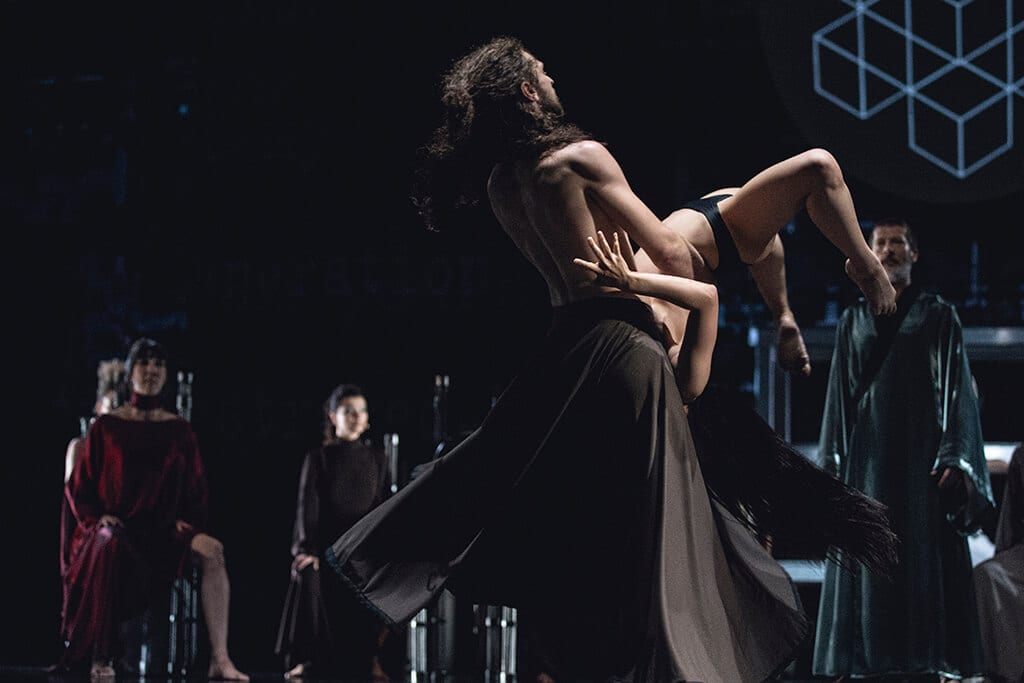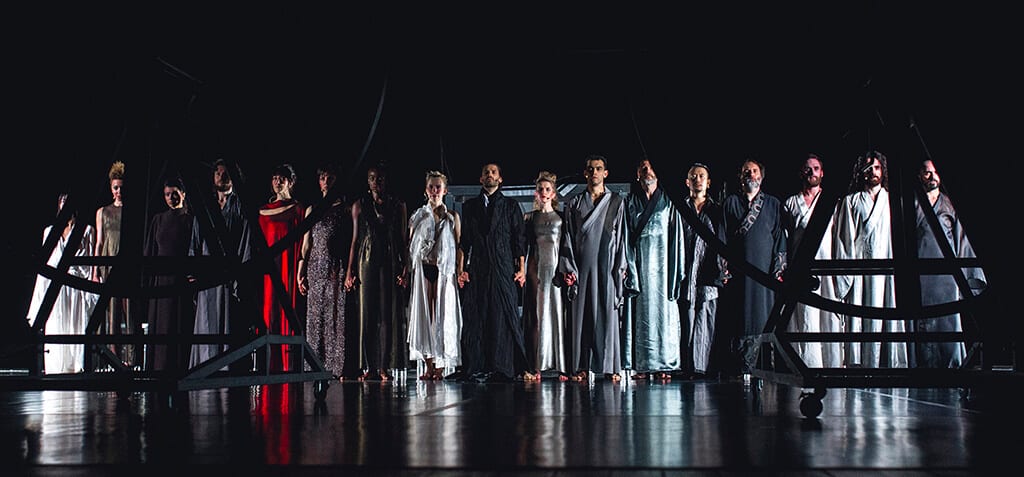The curtain goes up. The faint light illuminates fifteen iron high throne-like empty chairs. They wait for the actors (17 in total) who will invest all their intellectual and physical strength to take the audience to the world where there is no love. Inspired by Shakespeare Hamlet, the authors of “Crazy God” explore the limits of human cruelty and brutality. The fragments of the text of the drama intermingle with citations from Heiner Muller’s shockingly brutal text, Hamletmachine and Allan Ginsberg’s controversial poem “Howl”. The text is accompanied by various forms of physical action and polyphony.
As for the text of Grzegorz Bral’s drama, among all cited fragments, definitely the strongest artistic accent (together with the outstanding choral singing and various forms of dance) constitutes the original text of Shakespearean drama. The exceptionally rhythmical and melodious language once more proves to be timeless. Despite the fact that Hamlet is one of the most often staged dramas, the authors manage to add a new dimension to the Shakespearean text. For instance, Hamlet’s most known soliloquy from act 3, scene 1 – uttered by the black actress (Colette Dalal Tchantcho) who stands on the stage in the company of two other silent actors (Julianna Bloodgood and Henry McGrath) – is immediately followed by the dialog of Hamlet and his mother from act 3, scene 4 in which Hamlet expresses his grief caused by Gertrude’s too hasty marriage with Claudius, her deceased husband’s brother. After uttering the soliloquy Hamlet (Dalal Tchantcho) becomes one with Gertrude’s (Bloodgood) body and both actresses mutually utter Gertrude’s lines in the following dialog in which the role of Hamlet is further undertook by McGrath. Thanks to this treatment the audience can become aware how strong is the bond between the mother and the child, and that to a great extent Hamlet owes his hesitant nature to his mother who prefers comfortable marriage with Claudius more than searching for the true cause of her husband’s death.
Apart from the fact that the text of the drama is a collage of the three other aforementioned texts, as well as some of Alicja Bral’s poetry, Grzegorz Bral also chooses to use elements of various social and religious systems in the simplified form to answer the question about the limits of people’s pride who consider themselves gods on Earth, but in reality are just “Crazy Gods”. To give an example we should mention two main elements of the dance choreography which appear throughout the spectacle. The first one is the dance performed by the Kathakali dancer who for most of the time stands on the dais, towering over the other characters. His presence and dance symbolises the immemorial struggle between good and evil. The second element is a traditional dance of Sufis (whirling Sufi Dervishes) which is juxtaposed with deeply negative message of the text. This spinning dance, originally designed to imitate the movement of planets in the Solar System orbiting the sun, is traditionally a form of one of the worship rituals, Sema and a form of physically active meditation the aim of which is to increase physical, emotional and mental awareness and, on the ultimate level, to reach the source of all perfection (Kemal). In order to liberate oneself from all the constrains, one needs to let go of one’s egoistic incentives which imprison and limit our all-encompassing awareness which in the spectacle are symbolised inter alia by the wide skirt made of chains, so called tennure which normally is made of white material and is used in the ritual. The dance constitutes therefore one of ways through which one can potentially come into contact with the “dark side” of one’s nature.
But do the characters do it and are they able to transform those deeply rooted negative tendencies and habits? It seems that the answer is yes, since at the end of the spectacle, when the three of the characters (two of them playing Hamlet and Ophelia) are placed inside the round wooden constructions with luminous elements, appears an obvious reference to Leonardo Da Vinci’s “Vitruvian Man”. The bodies of the characters become inscribed in the circles and start to rotate moved by the other three characters. While creating his drawing, Leonardo not only wanted to represent man in his ideal proportions with the help of art and mathematics, but the work was also his attempt to relate man to nature – as the man of the Renaissance he believed that the human body constitutes a representation of the universe in its microscopic form. By using this image in the spectacle the main theme of which is the limits of human’s brutality the authors most probably wanted to show that only when one becomes fully conscious of this brutality one has a chance to surpass the limits of one’s body and mind, to become fully human, to become godlike. Additionally, the circular movement brings to mind the recurring cycle of existence. It is lack of consciousness of one’s “dark side” which causes the interruption of this cycle. It seems that the characters of the play manage to overcome their limitations. As the play ends at this point, it also seems that they challenge us to do the same. Are we able to take up the gauntlet?




